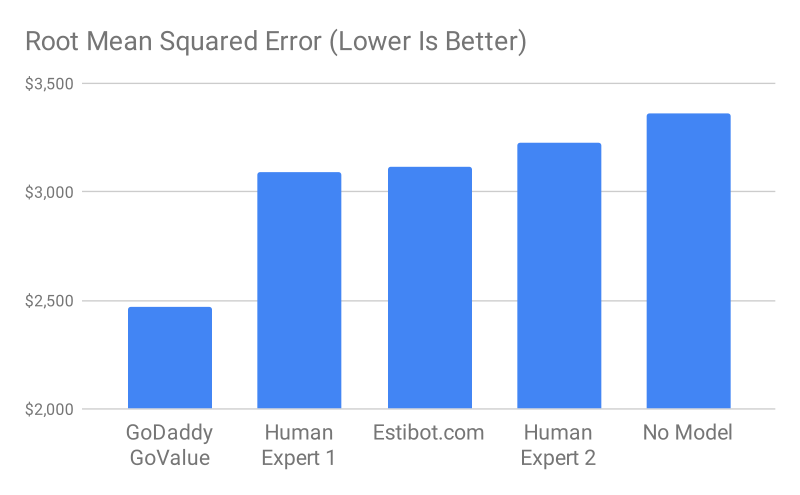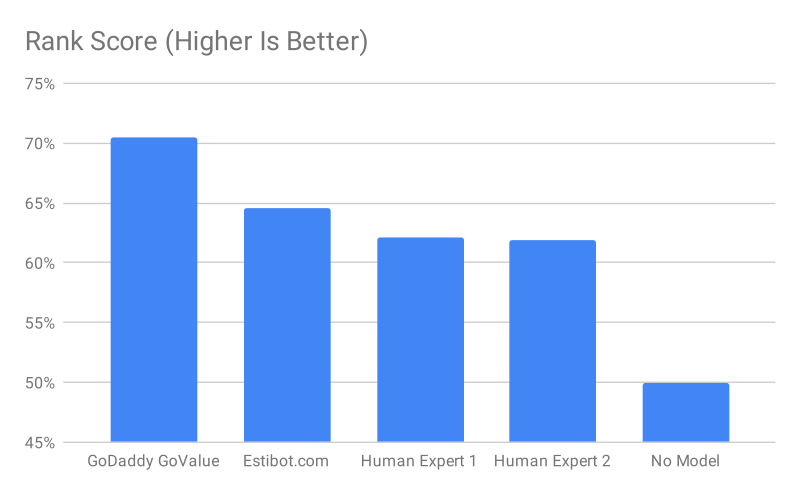Using Deep Learning for Domain Name Valuation
In 2017, GoDaddy launched GoDaddy Domain Appraisals also known as GoValue for predicting the value of a domain name on the aftermarket. Since 2017, we have continued to improve GoValue and it has been used by both buyers and sellers on the domain name aftermarket to better price premium domain names. This post dives into some of the technical details of how GoValue works. We will start by exploring some of the challenges of domain valuation in the aftermarket.
What is a name worth?
This can be a very difficult question to answer, but it is one that domain name investors need to answer every day. If you compare valuing a domain to valuing stocks, you can begin to see the difficulty of the problem. With stocks, you have vast amounts of data about a company’s financial performance, but with a domain name you have at most 63 characters. With stocks, there are millions of shares and a robust bid/ask spread, but with a domain name there is only one domain and once it is sold it may never be available again. In some sense, buying domains names is closer to buying unique pieces of art. It is a market dominated by experts who have developed the skill to value domain names through years of experience.
A simple answer to the question of what a name is worth is that it is worth what a buyer is willing to pay for it. However, in domain name investing there are two types of buyers. The first type of buyer is the domain name investor. Domain name investors are looking for good value in order to resell a name and typically either register new domain names or use auction websites, such as GoDaddy Auctions, that have much lower prices. The second type of buyer is an individual or business intending to use the domain name to build a website. If this type of buyer is willing to pay for a premium name (as opposed to finding an unregistered one), they may be willing to spend orders of magnitude more money than the domain name investor. However, for a specific name, there is a low probability that this second type of buyer will exist. What many domain name investors are trying to estimate is: 1) the probability there will be a buyer within a specific time period, and 2) how much that buyer will be willing to pay if they appear. The domain name investor will pay far less for a name because they must use the proceeds from the small percentage of the portfolio that sells to fund the names that don’t sell.
Different sellers have distinctive strategies when listing domain names. The following table shows the average ask price of ten of our top sellers in 2017 on Afternic. It also includes a portfolio quality score (normalized predicted GoValue), which will be discussed in more detail below.
| Average Ask Price | Portfolio Quality | Ask Price / Quality | |
|---|---|---|---|
| Seller 1 | $29,157 | 1.4 | $20,797 |
| Seller 2 | $9,183 | 1.13 | $8,148 |
| Seller 3 | $3,795 | 1.21 | $3,145 |
| Seller 4 | $2,523 | 1.07 | $2,360 |
| Seller 5 | $2,268 | 1.11 | $2,037 |
| Seller 6 | $2,000 | 0.66 | $3,026 |
| Seller 7 | $1,637 | 0.9 | $1,811 |
| Seller 8 | $1,268 | 0.77 | $1,647 |
| Seller 9 | $971 | 0.97 | $1,004 |
| Seller 10 | $349 | 0.78 | $447 |
The average ask prices vary by almost two orders of magnitude between different large sellers. Some sellers price domains higher. These sellers will make fewer total sales, but each sale will be large. Other sellers focus more on volume and price their domains lower. There is a complex trade-off between sales magnitude and sales quantity. This high variance in strategy combined with haggling in the sales process makes pricing domains especially difficult. If you ask each of these sellers what a single name is worth, you may get 10 different answers.
Valuation with machine learning
There has been a history of using machine learning to value domains. In 2012, GoDaddy released its first attempt at automated domain valuation. This system had underwhelming performance and thus was not well received. Estibot is another automated appraisals service which predates GoValue. GoDaddy Domain Appraisals (GoValue) was released 2017 and its usage has been increasing since then. Since each investor has a different pricing strategy, no one appraisal will satisfy everyone. We have recived positive feedback from many investors that GoValue is a useful tool in helping them understand their domain portfolio.
GoValue is based on a novel approach to domain valuation. This approach uses deep learning to leverage the vast amount of training data available only to GoDaddy as the world’s largest domain name marketplace. Modern techniques and unrivaled amounts of data have allowed GoDaddy to advance the state of the art in automated domain valuation.
To measure how well GoValue works, we asked two industry experts with years of experience to predict the sale prices for 2,000 Afternic sales from late 2017. These sales were a holdout set hidden from the GoValue model during training. We also compared to Estibot and “No Model” which simply predicts that everything will sell for the mean price. The following chart compares the root mean squared error (RMSE) of humans and machine predictions.

GoDaddy GoValue is significantly better at predicting past sale prices than both human experts and Estibot. RMSE is a standard metric for predicting these type of problems, however, one issue we see with both humans and Estibot is a bias where all predictions are either too high or too low.
To compare models in a way that ignores any systematic bias in the predictions, we introduce a metric rank score. The rank score measures each model (or human’s) ability to sort domains by the sales price, testing only if they got them in the right order. Rank score is defined as the probability that two randomly chosen domain name sales are put in the the correct order of higher and lower sales prices when ordered by the predicted sales prices. “No Model” has a rank score of 50% because if one orders two domains randomly, half the time they will be ordered correctly just by chance. The following shows each method’s rank score.

The results show that GoDaddy GoValue is better than human experts at predicting past sale prices for aftermarket domain names.
How does it work?
The first step is to tokenize the domain name into a series of words. This can sometimes be ambiguous, for example, bostonspark.com could either be Bostons Park or Boston Spark. To build a robust tokenizer, we need training data which can provide true tokenizations of domain names. To get this data, we crawled the web and used the content on each website to figure out the correct tokenization of their domain names. By finding the text from the domain name in the text of the website, we can see how the author intended a name to be tokenized. We use this data to build a vector representation of words and a tokenization model that is able to correctly resolve ambiguity as well as obscure words and phrases. We also use this tokenization and vector representation of words as an input to our domain valuation model.
The next issue that the model must solve is modeling the context of a sale. Just as different sellers have drastically different strategies, different marketplaces also have very different pricing trends that can change over time. For example, GoDaddy Auctions, used mostly by domain investors, has an average sale price of $170, while the Afternic reseller network has an average sale price of over $1,500. These differences in sale context can often account for more of the differences in price than the names themselves.
We simultaneously build a model of the sale context contribution to the price and a model of the domain name contribution to the price. This modeling of sales context allows us to train on data from a large variety of sellers and contexts and extract meaningful insights about domain prices across data sources. It also allows our model to output different price predictions for almost 300 different contexts where the sale might have happened.
There was also a large amount of feature engineering that went into building the model. Many of the model’s features come from the words, characters, and top-level domain (TLD). These features include detailed dictionaries spanning six different languages. Other features detect places, people, and things by using data from external sources such as Wikipedia. We also use information about how other similar domains with different TLDs are being used. In total, there are hundreds of different features that go into the model.
To put all of this together, we use a recurrent neural network (RNN) to process the words and per-word features of a domain. The output of this RNN feeds into a fully connected neural network to process the sale context and domain-level features. The following figure shows a simplified structure of our neural network:

Try GoValue For Yourself
Check out the GoValue for your domain name with GoDaddy Domain Appraisals. You could list your domain for sale or buy domains on GoDaddy Auctions or Afternic. In building GoValue and providing it for free, we hope that we can expand the domain investing community by making it easier to buy and sell domain names.
For more information about how GoDaddy Domain Appraisals work, check out this podcast.
Join us!
Interested in working on a challenging project like this? Check out the GoDaddy Jobs page to learn about all our current openings across the company.